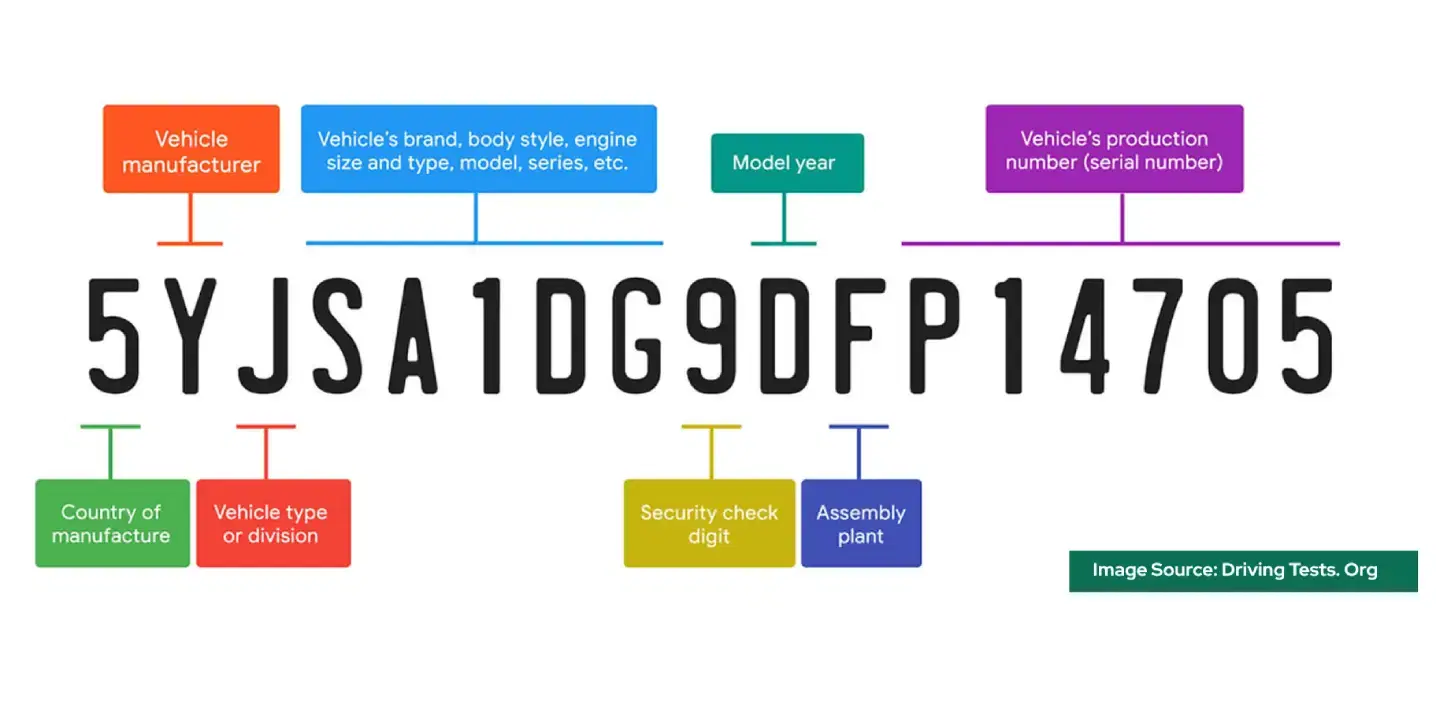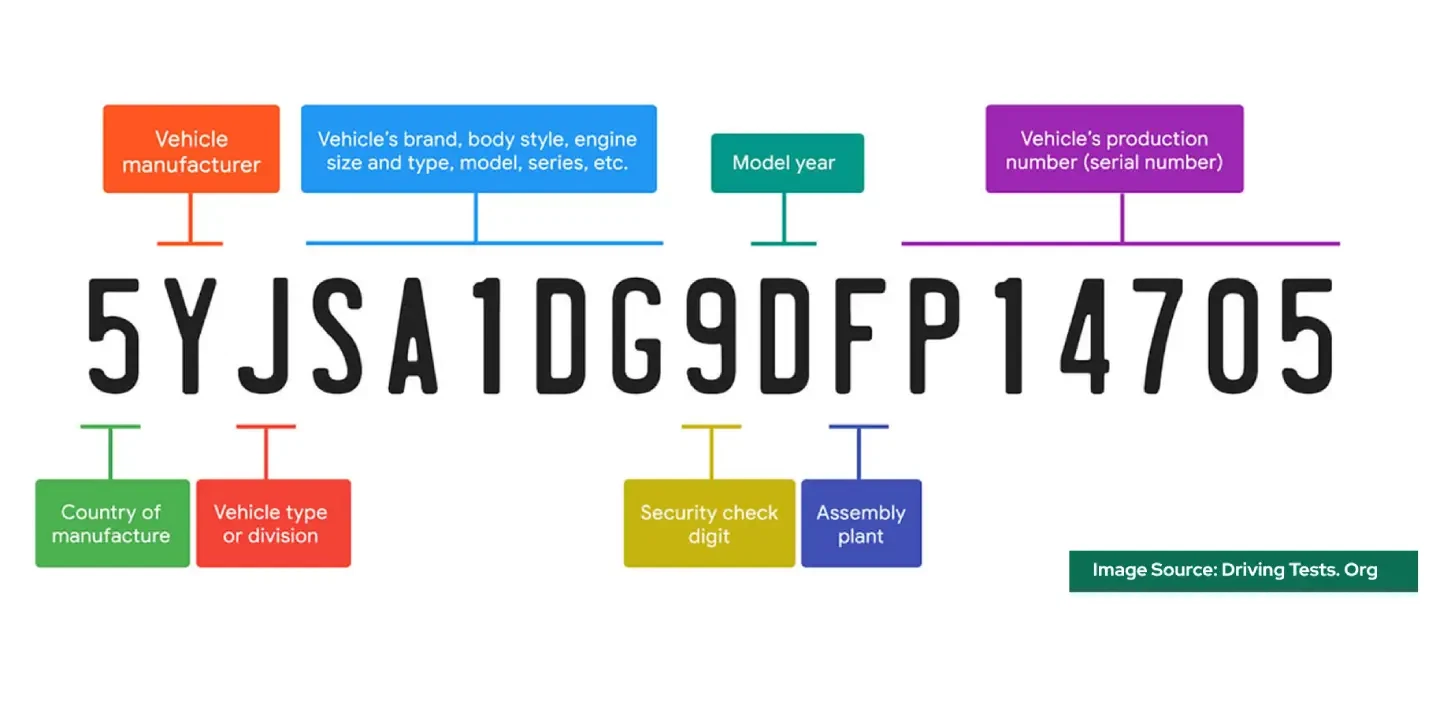
We’ve discussed VIN numbers in terms of bikes here previously, but the same stands true of cars as well. In fact, every car built after 1981 carries its own unique fingerprint, which, as you guessed correctly….is a VIN. This is true whether you’re buying a used car, checking recall history, verifying parts compatibility, or simply trying to confirm that your RC matches your vehicle.
In all of these cases, the VIN number is your single most important identifier.
Among all of this, the question still needs to be asked: What exactly does this 17-character code mean? More importantly, where is the VIN Number located in the car? Also, how (or if) is it possible to run a VIN number check? Can it be decoded properly?
We’re excited to bring you all of these answers in this guide. It breaks down everything in an easy-to-understand format with references to NHTSA, AutoCheck, Maruti/Hyundai VIN guides, as well as official ISO rules.
Excited to learn? Let’s get started.
What is a VIN and Why Does it Matter?¶
A VIN (Vehicle Identification Number) is a standardised, 17-character identity code assigned to every vehicle worldwide to uniquely identify it.
VIN number is extremely important in India. How? Here so:
- It confirms and signifies your identity, model year, manufacturing plant, and engine type
- It helps detect and push back against VIN cloning, stolen vehicles, tampering, or other illegal activities.
- Essential for recall history checks, correct spare parts, insurance, and emissions verification
What is the Key Difference Between VIN vs Chassis/Frame Number?¶
Although people often use both terms interchangeably, they are not the same thing. In fact, there are quite a few differences between both that need to be understood semantically:
| VIN (Vehicle Identification Number) | Chassis/Frame Number |
| Standardised 17-character format (ISO) | Format varies by manufacturer |
| Encodes WMI, VDS, VIS (region, maker, model, year, plant, serial) | Usually raw frame identifier; may be shorter |
| Used for global identification and decoding | Used internally for manufacturing & registration |
So what is the key takeaway?
Every car has a chassis number, but VIN is the global, standardised version that follows strict formatting rules.
VIN Format Explained: How Can We Understand the Full 17-Character Decoding Chart?¶
Every modern car’s VIN follows the ISO format:
1–3: WMI (World Manufacturer Identifier)
- Country + manufacturer
- Example: “MA3” for Maruti, “MAL” for Hyundai India
4–9: VDS (Vehicle Descriptor Section)
- Model, body style, engine, safety features
- Position 9 is the Check Digit used for validation
10: Model Year Code
- Alphabet/number representing the manufacturing year
11: Plant Code
- Identifies factory location
12–17: VIS (Vehicle Identifier Section)
- Serial/production sequence number
Letters I, O, and Q are never used to avoid confusion.
Want to learn the official decoding details? Explore: https://vpic.nhtsa.dot.gov/decoder
Where to Find the VIN on a Car?¶
Car manufacturers place VIN numbers in very predictable locations. Let’s explore this in detail:
Here are the primary visible locations for a VIN
- Driver-side dashboard (through windshield)
- Driver-side door jamb sticker
- Engine bay stamp (firewall/front chassis rail)
Here are some additional VIN locations
- Spare tire well / boot floor
- Under the front seat on older models
- Vehicle documents (RC, insurance policy, invoice)
- VIN tag inside glovebox (some models)
Want to explore this in terms of specific car brands? Well, here you go:
Hyundai VIN locations
- Driver door jamb
- Firewall stamp
- Some models include a label near the passenger fender
Maruti Suzuki VIN locations
- Door pillar / B-pillar
- Firewall
- Under bonnet stamping
How to Check / Lookup a VIN Online¶
1. Copy the 17-character VIN correctly
No spaces, no mistakes.
2. Use official decoders first
NHTSA vPIC Decoder: https://vpic.nhtsa.dot.gov/decoder
Through the decoder, you can find all the direct information regarding:
- Make
- Model
- Body type
- Engine type
- Safety equipment
- Manufacturing plant
- Model year
3. Use OEM-specific or region-specific decoders
For deeper India-specific decoding:
- Maruti VIN decode: V3Cars
- Hyundai VIN decode: Vindecoder
- General VIN decoders: Vindecoder
4. For full history: use Carfax / AutoCheck (paid)
This can reveal:
- Accident history
- Odometer rollback
- Salvage/rebuilt titles
Want to Understand it Practically? Here are Some Decoding Examples¶
Example 1 — Generic VIN
VIN: MA3EXXXS2L1234567
- MA3: Maruti Suzuki India (WMI)
- EXXXS2: Model & body descriptor (VDS)
- L: Model year (2020)
- 1: Plant code
- 234567: Serial number
Example 2 — Hyundai Example
VIN: MALAA51BLNM987654
- MAL: Hyundai India
- AA51BL: Variant + engine + safety info
- N: Model year (2022)
- M: Plant
- 987654: Serial number
How do VINs Differ According to the OEMS? Here are Some Important Tips.¶
Hyundai
- VIN is often stamped in the engine bay and printed on the B-pillar.
- Some models include an extra laminated label near the fender for easier scanning.
- Use Hyundai decode guides for accurate model-year identification.
Maruti Suzuki
- All Maruti VINs are 17 characters, following ISO standards.
- You can verify the year, plant, and model via online Maruti VIN decoders or the service centre.
- Maruti also stores VIN details in the service history database.
What are Some Important VIN Checks for Car Buyers? Here’s What to Verify¶
Before buying a used car, run through this checklist:
- VIN on the vehicle must match the VIN on RC, insurance, and invoice
- VIN decoding must show the correct make, model, year, fuel, and engine
- Check “Carfax/AutoCheck” for accident or flood records
- Look for salvage/rebuilt flags
- Verify odometer consistency
- Ensure registration state matches history
- Search the local stolen vehicle registry if applicable
- Inspect for grinding marks / repainting around dashboard VIN (VIN cloning sign)
What are the Common VIN Problems & Solutions/Quick Fixes?¶
Problem 1: VIN is not 17 characters
Solution: The can must be a pre-1981 or manufacturer variant; check the service manual.
Problem 2: VIN sticker is damaged / peeling
Solution: Visit the dealer for a reprint or verification letter.
Problem 3: VIN on dashboard does not match documents
Solution: Do not proceed. There has been a case of possible tampering.
Problem 4: VIN partially unreadable due to rust
Solution: Use a flashlight, chalk, or rubbing technique; dealer can help verify.
Problem 5: VIN clone suspected
Solution: Report immediately to the police; get a full VIN history report.
Frequently Asked Questions¶
1. What is VIN number for the car?
A 17-character global identification code that uniquely identifies a car’s make, model, year, engine, and manufacturing details. (ISO 3779/3780 – Wikipedia)
2. Are the VIN and chassis number the same?
No. VIN is standardised (17 characters); chassis/frame numbers vary in length and format depending on the manufacturer.
3. Where is VIN number of the car located?
On the dashboard near the windshield, driver door jamb, and engine bay stamp; also printed on RC and insurance.
4. How to find VIN number of a car quickly?
Stand outside the windshield and check the driver-side dashboard, or open the driver’s door and check the B-pillar sticker.
5. How to decode a VIN number?
Use the official NHTSA vPIC decoder to view make, model year, engine type, plant, and serial sequence.
6. What is VIN number example?
Example: MA3EXXXS2L1234567 — MA3 = Maruti, L = model year 2020, last 6 digits = serial.
7. How to check Maruti Suzuki VIN number online?
Use VIN tables on V3Cars or ask a Maruti service centre to decode the year and variant. (V3Cars)
8 . How to check Hyundai VIN number?
Use Hyundai VIN decode resources or V3Cars’ Hyundai VIN chart online.
Conclusion¶
Let’s summarise all the key things you need to understand when discussing VIN number for cars:
- Always verify that the VIN on the car matches the VIN on RC/insurance before purchasing.
- Decode the VIN using NHTSA/vPIC or OEM tools to confirm model year, engine, and variant.
- Check history (accidents, odometer, ownership) using trusted VIN lookup services, and avoid cars with mismatched or suspicious VINs.
A correct, verifiable VIN number is the strongest protection you have against fraud, misrepresentation, or bad purchases, and it takes just minutes to decode it properly.
Want to always be in on the know regarding car safety? Keep on following Ecozaar.
Based on 0 ratings
Abhishek Nair (Author)
With 8+ years of experience across manufacturing, banking, and sustainable e-commerce, he brings a sharp business lens to every conversation. An MBA with a love for football, motorsports, and all things fast—on the field or on two wheels.
Read moreRelated Blogs
Popular articles are selected based on the number of readers


